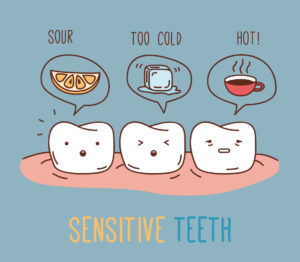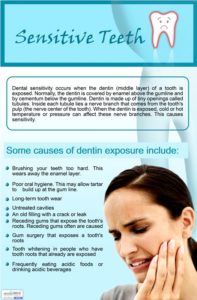Tooth sensitivity
Tooth sensitivity also known as dentin hypersensitivity — affects the tooth or exposed root surfaces. This occurs when the enamel that protects our teeth gets thinner, or when gum recession occurs, exposing the underlying surface, the dentin, thus, reducing the protection the enamel and gums provide to the tooth and root. Tooth sensitivity affects up to 57% of the population
Signs & Symptoms
If hot, cold, sweet or very acidic foods and drinks, or breathing in cold air, makes your teeth or a tooth sensitive or painful then you may have sensitive teeth. Tooth sensitivity can come and go over time.
What causes sensitive teeth?
The part of the tooth we can see has a layer of enamel that protects the softer dentine underneath. If the dentine is exposed, a tooth can become sensitive. This usually happens where the tooth and the gum meet and the enamel layer is much thinner. Here are some causes of sensitivity:
- Brushing too hard (‘toothbrush abrasion’), and brushing from side to side, can cause enamel to be worn away – particularly where the teeth meet the gums. The freshly exposed dentine may then become sensitive.
- Dental erosion: this is loss of tooth enamel caused by attacks of acid from acidic food and drinks. If enamel is worn away, the dentine underneath is exposed which may lead to sensitivity.
- Gums may naturally recede (shrink back), and the roots of the teeth will become exposed and can be more sensitive. Root surfaces do not have an enamel layer to protect them.
- Gum disease: a build-up of plaque or tartar can cause the gum to recede down the tooth and even destroy the bony support of the tooth. Pockets can form in the gums around the tooth, making the area difficult to keep clean and the problem worse.
- Tooth grinding: this is a habit which involves clenching and grinding the teeth together. This can cause the enamel of the teeth to be worn away, making the teeth sensitive.
- A cracked tooth or filling: a cracked tooth is one that has become broken. A crack can run from the biting surface of a tooth down towards the root. Extreme temperatures, especially cold, may cause discomfort.
- Tooth bleaching: some patients have sensitivity for a short time during bleaching or afterwards. Discuss this with your dental team before having treatment.


